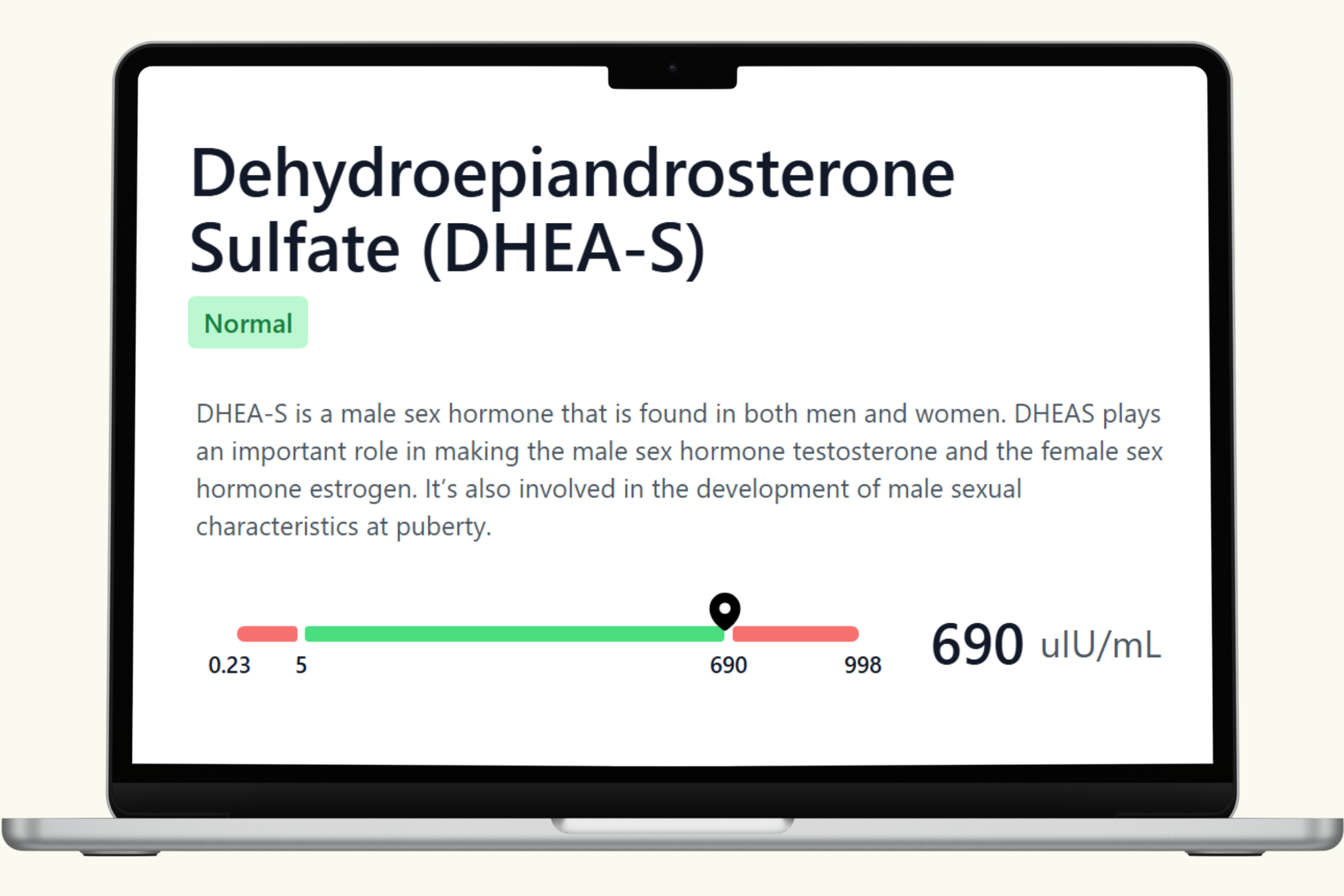DHEA-S Blood Test: Understanding the “Mother Hormone”
The DHEA-S Blood Test is an important part of the PlexusDx Cortisol & DHEAS Blood Test. This test measures levels of dehydroepiandrosterone sulfate (DHEA-S), a steroid hormone produced primarily by the adrenal glands. DHEA-S is often called the “mother hormone” because it serves as a precursor to both testosterone and estrogen, influencing a wide range of body functions. Measuring DHEA-S provides key insights into adrenal health, hormonal balance, aging, and overall vitality.
What is DHEA-S?
DHEA-S is the sulfated form of dehydroepiandrosterone (DHEA), which is the most abundant steroid hormone in circulation. The addition of a sulfate group makes DHEA-S more stable, allowing it to serve as a reservoir that can be converted back into active DHEA as needed. Production of DHEA-S peaks in early adulthood, then gradually declines with age, often paralleling the decline in vitality, libido, and muscle mass seen later in life. This decline makes DHEA-S an important biomarker of biological aging and adrenal performance.
Functions of DHEA-S
- Hormone Precursor: DHEA-S is converted into testosterone and estrogen, supporting reproductive health and secondary sexual characteristics.
- Anti-Aging Effects: Higher levels are associated with youthful energy, improved skin health, and better cognitive performance.
- Immune Regulation: DHEA-S helps modulate immune function, balancing inflammation and immune defense.
- Mood & Cognition: Adequate DHEA-S supports neurotransmitter function and may enhance mood, resilience, and memory.
- Bone & Muscle Health: DHEA-S contributes to bone density, muscle strength, and metabolic health.
Why Test DHEA-S?
Abnormal levels of DHEA-S can reflect adrenal imbalance, premature aging, or underlying health issues. Testing is especially useful for individuals experiencing:
- Unexplained fatigue or low energy
- Decreased libido or sexual dysfunction
- Mood changes such as depression, anxiety, or irritability
- Bone loss or early osteoporosis
- Loss of muscle tone or unexplained weight changes
- Symptoms of adrenal dysfunction, such as those also linked with abnormal cortisol levels
Because DHEA-S interacts closely with cortisol, measuring both hormones together offers a comprehensive picture of adrenal health and the body’s ability to manage stress and maintain hormonal balance.
Specimen Collection Method
PlexusDx makes it simple to measure DHEA-S from home. The at-home dried blood spot collection method using an ADX card requires just a small finger-prick blood sample. Once applied and dried, the sample is stable and easy to ship to the laboratory for analysis. This at-home method provides accurate and reliable results without requiring a trip to a clinic.
DHEA-S Reference Ranges
DHEA-S levels vary significantly depending on age and sex. Below are commonly reported laboratory ranges (mcg/dL):
Standard Laboratory Ranges (approximate)
- Men (20–29 years): 280 – 640 mcg/dL
- Men (30–39 years): 120 – 520 mcg/dL
- Men (40–49 years): 95 – 530 mcg/dL
- Men (50–59 years): 70 – 310 mcg/dL
- Men (60+ years): 42 – 290 mcg/dL
- Women (20–29 years): 65 – 380 mcg/dL
- Women (30–39 years): 45 – 270 mcg/dL
- Women (40–49 years): 32 – 240 mcg/dL
- Women (50–59 years): 26 – 200 mcg/dL
- Women (60+ years): 13 – 130 mcg/dL
Functional Medicine Ranges
Functional ranges tend to be narrower and reflect optimal rather than average health status. While exact ranges may vary by practitioner, optimal values typically fall in the upper half of the standard ranges for young adults, reflecting peak vitality and adrenal function.
Conditions Associated with Abnormal DHEA-S Levels
- Low DHEA-S: Associated with adrenal insufficiency, aging, chronic illness, low libido, fatigue, depression, and osteoporosis.
- High DHEA-S: May indicate adrenal hyperplasia, adrenal tumors, polycystic ovary syndrome (PCOS), or excessive stress load.
- Imbalanced Cortisol/DHEA Ratio: When cortisol is high and DHEA-S is low, the body may be in a chronic stress state, leading to burnout, immune suppression, and accelerated aging.
How DHEA-S Testing Supports Health Decisions
Knowing your DHEA-S levels can guide health and wellness strategies:
- Hormonal Balance: Identifying low DHEA-S can guide treatment options, such as lifestyle changes, nutrient support, or hormone replacement therapy under medical supervision.
- Stress Management: Monitoring the cortisol-to-DHEA ratio provides a more complete picture of adrenal health, guiding stress-reduction strategies.
- Healthy Aging: Optimizing DHEA-S may support longevity, vitality, sexual health, and cognitive function.
- Bone & Muscle Health: Maintaining adequate DHEA-S supports skeletal strength and helps preserve lean body mass.
Advantages of At-Home DHEA-S Testing
The PlexusDx Cortisol & DHEAS Blood Test provides unique advantages over traditional hormone testing:
- Convenient at-home collection with a dried blood spot on an ADX card
- Stable samples that are easy to ship without special handling
- Comprehensive adrenal insight when paired with cortisol testing
- Access to both standard and functional health reference ranges
Conclusion
The DHEA-S Blood Test, included in the PlexusDx Cortisol & DHEAS Blood Test, provides valuable insight into adrenal and hormonal health. DHEA-S is a powerful biomarker of vitality, stress resilience, and biological aging. Low levels may contribute to fatigue, mood disturbances, and premature aging, while high levels may signal hormonal imbalance or adrenal overactivity. With a simple at-home dried blood spot collection method using an ADX card, PlexusDx makes it easy to check this critical hormone and take proactive steps toward restoring balance, improving energy, and supporting long-term health.

Share:
Cortisol Blood Test